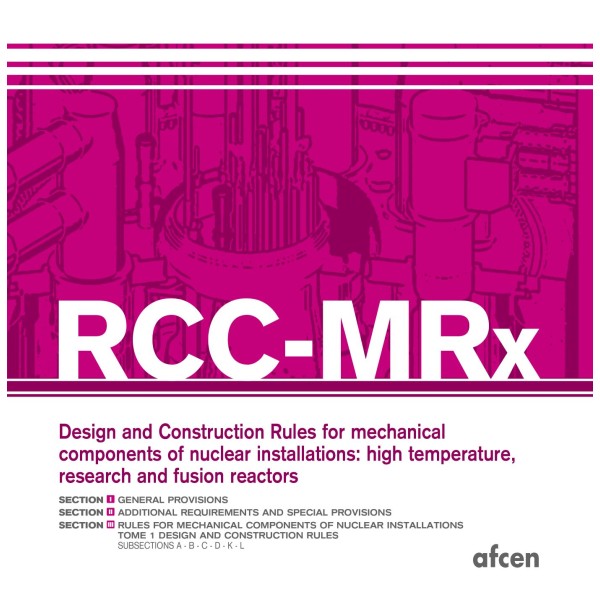- New!
RCC-MRx 2022
Reference: AFC284
Design and construction rules for mechanical components of nuclear installations: high temperature, research and fusion reactors


• Materials procurements: integration of a RPS dedicated to 6061-T6 aluminium alloy flanges obtained by ring forging for the core housing of RJH or RPS for procurement of beryllium billets.
• Fabrication:
- Possibility to use polymer quenching (as an alternative to oil quenching),
- Reinforcement of requirements for nitriding and introduction of ionic processes,
- Introduction of specific rules for shearing and forming of heat exchanger plates (plate and joint type).
In addition, the following major evolutions are added:
- Creation of a properties group for X2CrNi19-10 nitrogen controlled steel [« 304L(N) »], in RPP18.
- Introduction of the CuCrZr grade (RPS and A3) in RPP23.
- Improvement of creep-fatigue rules.
- Creation of a Subsection G dedicated to core internals.
- Complete reorganization of the Tome 2 to clarify its use by gathering in a single place the procurements according to standards.
This Code of design and construction rules for mechanical component in Nuclear Installations (RCC-MRx) is one of the works in the collection of design and construction rules for nuclear plants initiated by RCC-M for Pressurized Water Reactors (PWR).
The scope of application of the RCC-MRx design and construction rules is limited to mechanical component:
• considered to be important in terms of nuclear safety and operability,
• playing a role in ensuring leaktightness, partitioning, guiding, securing and supporting,
• containing fluids such as pumps, valves, pipes, bellows, box structures, heat exchangers, irradiation devices, handling and driving mechanisms and the associated supports, when existing.
RCC-MRx code is organized with three sections:
• Section I: general provisions common to the entire code,
• Section II: additional requirements for the alternative use of other applicable rule sets (Standards EN 13445 and EN 13480 for instance) for Class N3Rx component, and special instructions for component subject to regulation such as pressure equipment or nuclear pressure equipment or such as REACh.
• Section III: set of applicable rules, adopting the format of RCC-M, RCC-MR or RCC-MX codes with five Tomes, Tome 1 being sub-divided into subsections:
- Tome 1 contains the design and construction rules and comprises subsections which are alphanumerically numbered:
* Subsection A: general provisions for Section III,
* Subsection B: class N1Rx components and supports of the nuclear reactor and its auxiliary systems,
* Subsection C: class N2Rx components and supports of the nuclear reactor and its auxiliary systems,
* Subsection D: class N3Rx components and supports of the nuclear reactor and its auxiliary systems,
* Subsection K: examination, handling or drive mechanisms covering all classes,
* Subsection G: core internals,
* Subsection L: components of irradiation devices covering all classes,
* Subsection Z: technical appendices.
- Tomes 2 to 5 contain the rules corresponding to various technical areas:
* Tome 2: part and product procurement specifications,
* Tome 3: destructive tests and non-destructive examination methods,
* Tome 4: qualifications for welding operations and welding procedures and their application,
* Tome 5: manufacturing operations other than welding.
- Tome 6 contains collection of probationary phase rules.
==========
Erratas of the RCC-MRx code have been published, follow this link: Erratas of RCC-MRx code.

Take part in updating the codes
If you would like to modify a code, you can send your proposal to the relevant code subcommittee: download and complete the application form, then send the form to the subcommittee email address.
If you would like to understand the interpretation of a paragraph of the code: download the application form, enter your question and send the form to the email address of the relevant subcommittee.
If you want to benefit the nuclear industry from your feedback as a code user, share your expertise with AFCEN: download and complete the application form, then send it to the email address of the relevant subcommittee.

